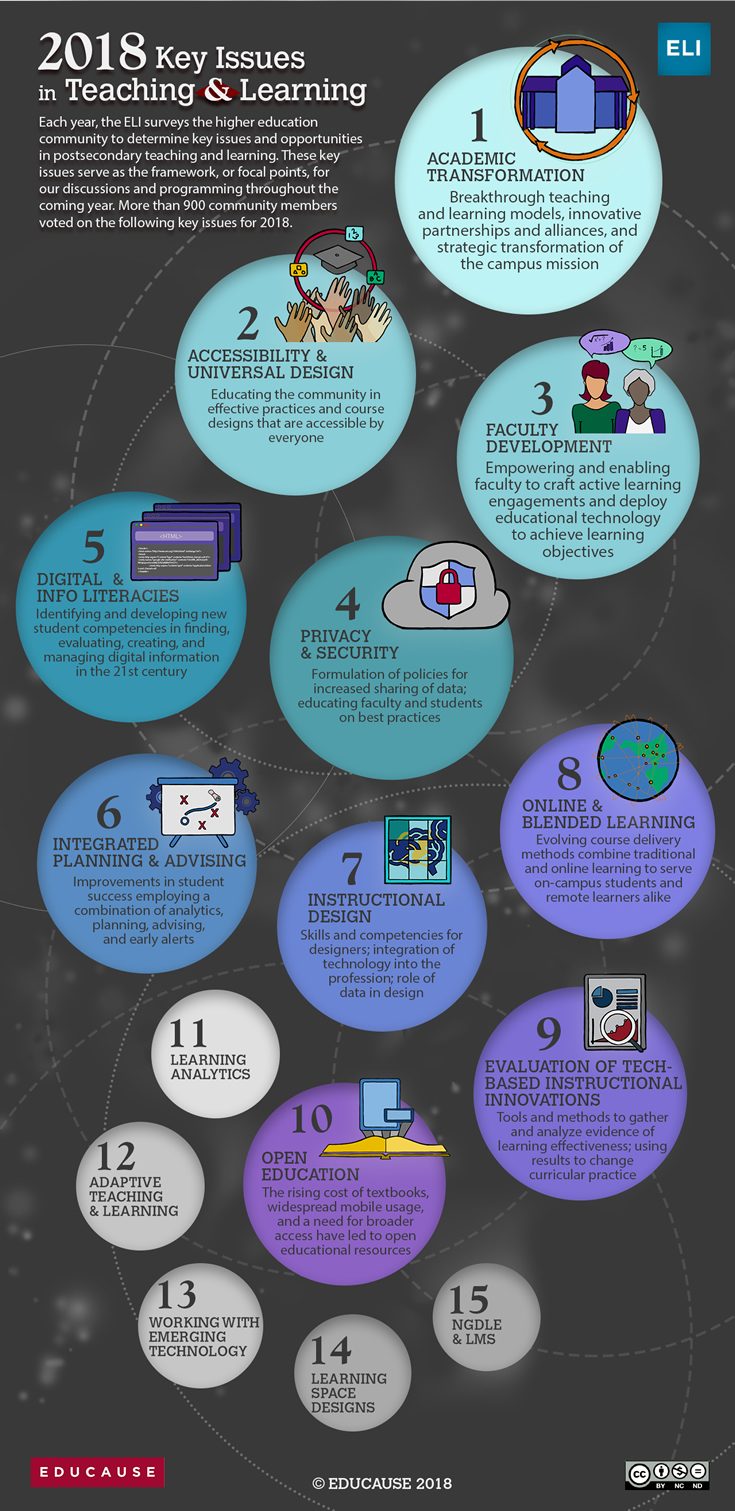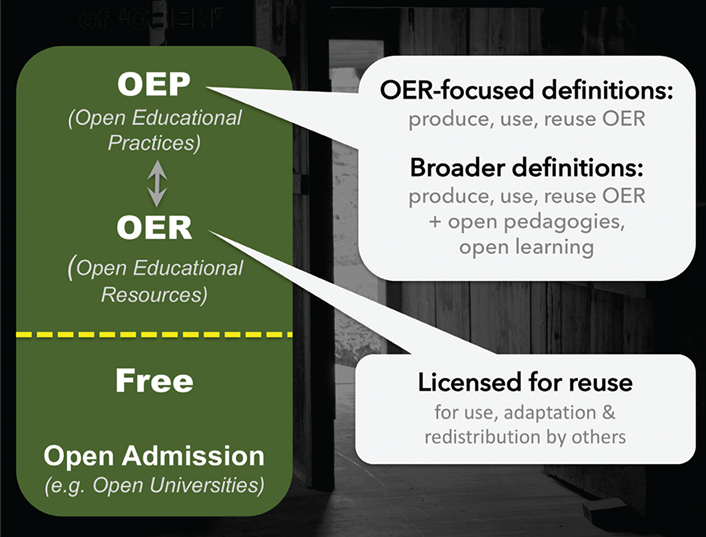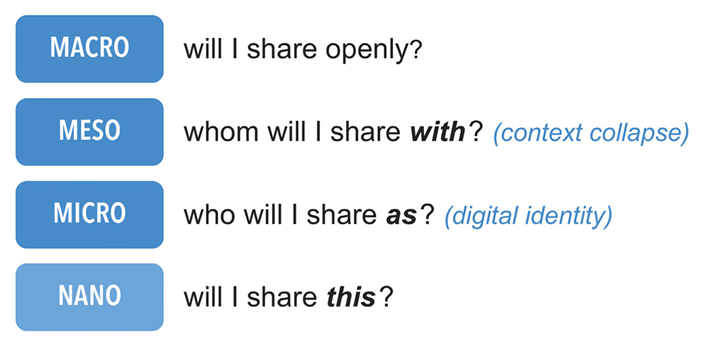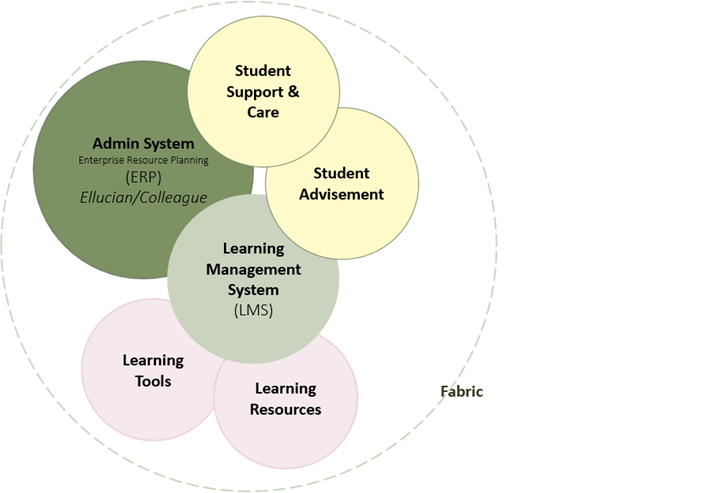The Next 10 Years: Helping STEM Students Thrive series, on January 10th, from 12-1:30 PM ET. The topic will be learning spaces with the following guest speakers:
- Jeanne L. Narum, Principal, Learning Spaces Collaboratory
Jeanne will discuss what she has learned about what works, why and how it works in achieving sustainable institutional transformation in the world of planning spaces for learning in the undergraduate setting.
- Lisa Stephens, Sr. Strategist- SUNY Academic Innovation – University at Buffalo
- Rebecca Rotundo, Instructional Technology Specialist, University at Buffalo
Lisa and Rebecca will share their experience in FLEXspace (Flexible Learning Environments eXchange) an open education repository project which has expanded to over 2,600+ users from 1,200+ educational institutions across 42 countries.
- Xin Li, Associate University Librarian, Cornell
Xin will share information about the Library’s initiative to install a Portal on the Cornell campus in Sept. 2018, with the goal to engage faculty, students, and the community in live conversations with Portal users in different countries, cultures, or life circumstances, such as what others do for STEM education.
For more information on the speakers and to register and log into the event please go tohttps://gateway.shindig.com/event/learningspaces
This collaboration between Cornell University and the University at Buffalo featuring the perspectives of national thought leaders and institutional representatives about expanding the participation of women in undergraduate STEM education at different scales.
This interactive, online series features a different topic per month. Each session kicks off with an introduction by our distinguished thought leaders followed by institutional representatives from Cornell University and the University at Buffalo who will share insights from their campuses. Participants may join the conversation, ask questions, share experiences, build networks and learn more about:
· Innovations that can expand female or underrepresented minority student participation and success in STEM undergraduate education.
· Effective evidence-based STEM teaching practices commonly adopted at research universities.
· Unique institutional and cultural challenges to achieving STEM diversity.
· What difference at scale looks like.
+++++++++++++++
more on learning spaces in academic environment in this iMS blog
https://blog.stcloudstate.edu/ims?s=learning+spaces
BLEND-ONLINE : Call for Chapter Proposals– Privacy and Remote Learning
Digital Scholarship Initiatives at Middle Tennessee State University invites you to propose a chapter for our forthcoming book.
Working book title: Privacy and Safety in Remote Learning Environments
Proposal submission deadline: January 21, 2022
Interdisciplinary perspectives are highly encouraged
Topics may include but are not limited to:
- Privacy policies of 3rd party EdTech platforms (Google Classroom, Microsoft Teams, Schoology, etc)
- Parental “spying” and classroom privacy
- Family privacy and synchronous online schooling
- Online harassment among students (private chats, doxing, social media, etc)
- Cameras in student private spaces
- Surveillance of student online activities
- Exam proctoring software and privacy concerns
- Personally Identifiable Information in online learning systems and susceptibility to cybercriminals
- Privacy, storage, and deletion policies for recordings and data
- Handling data removal requests from students
- Appointing a privacy expert in schools, universities, or districts
- How and why to perform security/privacy audits
- Student attitudes about online privacy
- Instructor privacy/safety concerns
- Libraries: privacy policies of ebook platforms
- Libraries: online reference services and transcripts
- Identity authentication best practices
- Learning analytics and “big data” in higher education
More details, timelines, and submission instructions are available at dsi.mtsu.edu/cfpBook2022
Literature on project based learning for K 12
Keywords | search strategy:
project-based learning, kindergarten to high school, online leaching ? Online learning? Methodology? Online platforms.
старо но точно по темата:
Cathy Cavanaugh, & Kara Dawson. (2010). Design of Online Professional Development in Science Content and Pedagogy: A Pilot Study in Florida. Journal of Science Education and Technology, 19(5), 438–446. https://doi.org/10.1007/s10956-010-9210-2
https://mnpals-scs.primo.exlibrisgroup.com/permalink/01MNPALS_SCS/ppvqcp/cdi_proquest_journals_2259584669
flipped classroom зависи от културни особености. това изследване може да важи за Щатите, но не за България:
Raffaghelli, J. (2017). Does Flipped Classroom work? Critical analysis of empirical evidences on its effectiveness for learning. Form@re : Open Journal Per La Formazione in Rete, 17(3). https://doi.org/10.13128/formare-21216
https://mnpals-scs.primo.exlibrisgroup.com/permalink/01MNPALS_SCS/ppvqcp/cdi_doaj_primary_oai_doaj_org_article_589dc480fa9a48cd828561173c625b39
изследване от Турция
Şahin, S., & Baturay, M. (2016). The effect of 5E-learning model supported with WebQuest media on students’ achievement and satisfaction. E-Learning and Digital Media, 13(3-4), 158–175. https://doi.org/10.1177/2042753016672903
https://mnpals-scs.primo.exlibrisgroup.com/permalink/01MNPALS_SCS/ppvqcp/cdi_crossref_primary_10_1177_2042753016672903
изследване от Гърция|
Georgios FESSAKIS, & Stavroula PRANTSOUDI. (2019). Computer Science Teachers’ Perceptions, Beliefs and Attitudes on Computational Thinking in Greece. Informatics in Education, 18(2), 227–258. https://doi.org/10.15388/infedu.2019.11
Lee, D., Huh, Y., Lin, C., & Reigeluth, C. (2018). Technology functions for personalized learning in learner-centered schools. Educational Technology Research and Development, 66(5), 1269–1302. https://doi.org/10.1007/s11423-018-9615-9
https://mnpals-scs.primo.exlibrisgroup.com/permalink/01MNPALS_SCS/ppvqcp/cdi_proquest_journals_2071965296
Brookes, T. (2017). Design challenges: Connecting the classroom to the real world. Teaching Science, 63(4), 16–19. Retrieved from http://eric.ed.gov/ERICWebPortal/detail?accno=EJ1165661
https://mnpals-scs.primo.exlibrisgroup.com/permalink/01MNPALS_SCS/ppvqcp/cdi_proquest_journals_1979139411
училищен библиотекар да работи с преподавател над учебен план много трудно ще стане в съврменна България, но не е невъзможно:
Boyer, B. (2015). Designer Librarian: Embedded in K12 Online Learning. 59(3), 71–76. https://doi.org/10.1007/s11528-015-0855-9
https://mnpals-scs.primo.exlibrisgroup.com/permalink/01MNPALS_SCS/ppvqcp/cdi_proquest_journals_1675592618
Educause прогнозира нарастваща роля на instructional designer при съставянето на учебни планове: e.g. https://blog.stcloudstate.edu/ims/2019/04/24/2019-educause-horizon-report/; https://blog.stcloudstate.edu/ims/2018/11/09/new-directions-in-instructional-design/; https://blog.stcloudstate.edu/ims/2019/01/06/future-of-libraries-with-instructional-design/; https://blog.stcloudstate.edu/ims/2017/01/04/instructional-design-librarian-2/
Lindsey M Swagerty, & Tara Hodge. (2019). fostering creativity and curiosity: developing safer elementary STEM learning spaces. Technology and Engineering Teacher, 78(8), 20–23. Retrieved from https://search.proquest.com/docview/2226390222
https://mnpals-scs.primo.exlibrisgroup.com/permalink/01MNPALS_SCS/ppvqcp/cdi_proquest_journals_2226390222
Tandra L. Tyler-Wood, Deborah Cockerham, & Karen R. Johnson. (2018). Implementing new technologies in a middle school curriculum: a rural perspective. Smart Learning Environments, 5(1), 1–16. https://doi.org/10.1186/s40561-018-0073-y
https://mnpals-scs.primo.exlibrisgroup.com/permalink/01MNPALS_SCS/ppvqcp/cdi_doaj_primary_oai_doaj_org_article_6b4a31d0f8b9471bbe2d291cba18719b
Justin Weidman, & Geoffrey Wright. (2019). promoting construction education in K-12 by using an experiential, student-centered, STEM-infused construction unit. Technology and Engineering Teacher, 79(1), 8–12. Retrieved from https://search.proquest.com/docview/2309762278
https://mnpals-scs.primo.exlibrisgroup.com/permalink/01MNPALS_SCS/ppvqcp/cdi_proquest_journals_2309762278
това е за твоя офис за професионално ориентиране:
Destinations Career Academies Offer Support to Schools, Families Disrupted by Coronavirus (p. 68–). (2020). NewsRX LLC.
https://mnpals-scs.primo.exlibrisgroup.com/permalink/01MNPALS_SCS/ppvqcp/cdi_gale_healthsolutions_A617560083
Schachter, R. (2013). Project-based learning 2.0: technology pushes PBL into fifth gear in K12. 49(12), 60–.
https://mnpals-scs.primo.exlibrisgroup.com/permalink/01MNPALS_SCS/ppvqcp/cdi_gale_infotracacademiconefile_A353319541
Lee, D., Huh, Y., Lin, C., & Reigeluth, C. (2018). Technology functions for personalized learning in learner-centered schools. Educational Technology Research and Development, 66(5), 1269–1302. https://doi.org/10.1007/s11423-018-9615-9
https://mnpals-scs.primo.exlibrisgroup.com/permalink/01MNPALS_SCS/ppvqcp/cdi_proquest_journals_2071965296
From ResearchGate:
Amissah, P. (2019). ADVANTAGES AND CHALLENGES OF ONLINE PROJECT-BASED LEARNING [MS Media Arts and Technology]. https://www.researchgate.net/publication/336614010_ADVANTAGES_AND_CHALLENGES_OF_ONLINE_PROJECT-BASED_LEARNING
Ching, Y.-H., & Hsu, Y.-C. (2011). Incorporating peer feedback for learning in a project-based online learning environment. ResearchGate. https://www.researchgate.net/publication/277987113_Incorporating_peer_feedback_for_learning_in_a_project-based_online_learning_environment
Handoyono, N. A., & Rabiman, R. (n.d.).
(PDF) Improvement of Learning Motivation and Learning Outcomes by Applying The Problem Based-Learning Method. ResearchGate. Retrieved March 22, 2020, from
https://www.researchgate.net/publication/338796878_Improvement_of_Learning_Motivation_and_Learning_Outcomes_by_Applying_The_Problem_Based-Learning_MethodTran, T. Q., & Ngoc Tu, T. P. (2019). (PDF) The Important Roles of Project-Based Learning in Teaching English to High School Students.
ResearchGate.
https://www.researchgate.net/publication/333935026_The_Important_Roles_of_Project-Based_Learning_in_Teaching_English_to_High_School_StudentsZakaria, A., Salleh, A., Ismail, Mohd. S., & Ghavifekr, S. (2019).
(PDF) Cultivating Positive Values via Online Project-Based Module (m-PAT). ResearchGate.
https://www.researchgate.net/publication/334044540_Cultivating_Positive_Values_via_Online_Project-Based_Module_m-PATFrom Academia.com
VIA (very important article):
McDougall, J., Readman, M., & Wilkinson, P. (2018). The uses of (digital) literacy. Learning, Media and Technology, 43(3), 263–279. https://doi.org/10.1080/17439884.2018.1462206
How Game-Based Learning Empowers Students for the Future
https://www.edsurge.com/news/2019-01-22-its-2019-so-why-do-21st-century-skills-still-matter
educators’ guide to game-based learning, packed with resources for gaming gurus and greenhorns alike.
How are schools and districts preparing students for future opportunities? What is the impact of game-based learning?
It’s 2019. So Why Do 21st-Century Skills Still Matter?
21st-century trends such as makerspaces, flipped learning, genius hour, gamification, and more.
EdLeader21, a national network of Battelle for Kids.has developed a toolkit to guide districts and independent schools in developing their own “portrait of a graduate” as a visioning exercise. In some communities, global citizenship rises to the top of the wish list of desired outcomes. Others emphasize entrepreneurship, civic engagement, or traits like persistence or self-management.
ISTE Standards for Students highlight digital citizenship and computational thinking as key skills that will enable students to thrive as empowered learners. The U.S. Department of Education describes a globally competent student as one who can investigate the world, weigh perspectives, communicate effectively with diverse audiences, and take action.
Frameworks provide mental models, but “don’t usually help educators know what to do differently,” argues technology leadership expert Scott McLeod in his latest book, Harnessing Technology for Deeper Learning. He and co-author Julie Graber outline deliberate shifts that help teachers redesign traditional lessons to emphasize goals such as critical thinking, authenticity, and conceptual understanding.
1. Wondering how to teach and assess 21st-century competencies? The Buck Institute for Education offers a wide range of resources, including the book, PBL for 21st Century Success: Teaching Critical Thinking, Collaboration, Communication, and Creativity (Boss, 2013), and downloadable rubrics for each of the 4Cs.
2. For more strategies about harnessing technology for deeper learning,listen to the EdSurge podcast featuring edtech expert and author Scott McLeod.
3. Eager to see 21st-century learning in action? Getting Smart offers suggestions for using school visits as a springboard for professional learning, including a list of recommended sites. Bob Pearlman, a leader in 21st century learning, offers more recommendations.
++++++++++++++
more on game- based learning in this IMS blog
https://blog.stcloudstate.edu/ims?s=game+based
Key Issues in Teaching and Learning
https://www.educause.edu/eli/initiatives/key-issues-in-teaching-and-learning
A roster of results since 2011 is here.

1. Academic Transformation
2. Accessibility and UDL
3. Faculty Development
4. Privacy and Security
5. Digital and Information Literacies
https://cdn.nmc.org/media/2017-nmc-strategic-brief-digital-literacy-in-higher-education-II.pdf
Three Models of Digital Literacy: Universal, Creative, Literacy Across Disciplines
United States digital literacy frameworks tend to focus on educational policy details and personal empowerment, the latter encouraging learners to become more effective students, better creators, smarter information consumers, and more influential members of their community.
National policies are vitally important in European digital literacy work, unsurprising for a continent well populated with nation-states and struggling to redefine itself, while still trying to grow economies in the wake of the 2008 financial crisis and subsequent financial pressures
African digital literacy is more business-oriented.
Middle Eastern nations offer yet another variation, with a strong focus on media literacy. As with other regions, this can be a response to countries with strong state influence or control over local media. It can also represent a drive to produce more locally-sourced content, as opposed to consuming material from abroad, which may elicit criticism of neocolonialism or religious challenges.
p. 14 Digital literacy for Humanities: What does it mean to be digitally literate in history, literature, or philosophy? Creativity in these disciplines often involves textuality, given the large role writing plays in them, as, for example, in the Folger Shakespeare Library’s instructor’s guide. In the digital realm, this can include web-based writing through social media, along with the creation of multimedia projects through posters, presentations, and video. Information literacy remains a key part of digital literacy in the humanities. The digital humanities movement has not seen much connection with digital literacy, unfortunately, but their alignment seems likely, given the turn toward using digital technologies to explore humanities questions. That development could then foster a spread of other technologies and approaches to the rest of the humanities, including mapping, data visualization, text mining, web-based digital archives, and “distant reading” (working with very large bodies of texts). The digital humanities’ emphasis on making projects may also increase
Digital Literacy for Business: Digital literacy in this world is focused on manipulation of data, from spreadsheets to more advanced modeling software, leading up to degrees in management information systems. Management classes unsurprisingly focus on how to organize people working on and with digital tools.
Digital Literacy for Computer Science: Naturally, coding appears as a central competency within this discipline. Other aspects of the digital world feature prominently, including hardware and network architecture. Some courses housed within the computer science discipline offer a deeper examination of the impact of computing on society and politics, along with how to use digital tools. Media production plays a minor role here, beyond publications (posters, videos), as many institutions assign multimedia to other departments. Looking forward to a future when automation has become both more widespread and powerful, developing artificial intelligence projects will potentially play a role in computer science literacy.
6. Integrated Planning and Advising Systems for Student Success (iPASS)
7. Instructional Design
8. Online and Blended Learning
In traditional instruction, students’ first contact with new ideas happens in class, usually through direct instruction from the professor; after exposure to the basics, students are turned out of the classroom to tackle the most difficult tasks in learning — those that involve application, analysis, synthesis, and creativity — in their individual spaces. Flipped learning reverses this, by moving first contact with new concepts to the individual space and using the newly-expanded time in class for students to pursue difficult, higher-level tasks together, with the instructor as a guide.
Let’s take a look at some of the myths about flipped learning and try to find the facts.
Myth: Flipped learning is predicated on recording videos for students to watch before class.
Fact: Flipped learning does not require video. Although many real-life implementations of flipped learning use video, there’s nothing that says video must be used. In fact, one of the earliest instances of flipped learning — Eric Mazur’s peer instruction concept, used in Harvard physics classes — uses no video but rather an online text outfitted with social annotation software. And one of the most successful public instances of flipped learning, an edX course on numerical methods designed by Lorena Barba of George Washington University, uses precisely one video. Video is simply not necessary for flipped learning, and many alternatives to video can lead to effective flipped learning environments [http://rtalbert.org/flipped-learning-without-video/].
Myth: Flipped learning replaces face-to-face teaching.
Fact: Flipped learning optimizes face-to-face teaching. Flipped learning may (but does not always) replace lectures in class, but this is not to say that it replaces teaching. Teaching and “telling” are not the same thing.
Myth: Flipped learning has no evidence to back up its effectiveness.
Fact: Flipped learning research is growing at an exponential pace and has been since at least 2014. That research — 131 peer-reviewed articles in the first half of 2017 alone — includes results from primary, secondary, and postsecondary education in nearly every discipline, most showing significant improvements in student learning, motivation, and critical thinking skills.
Myth: Flipped learning is a fad.
Fact: Flipped learning has been with us in the form defined here for nearly 20 years.
Myth: People have been doing flipped learning for centuries.
Fact: Flipped learning is not just a rebranding of old techniques. The basic concept of students doing individually active work to encounter new ideas that are then built upon in class is almost as old as the university itself. So flipped learning is, in a real sense, a modern means of returning higher education to its roots. Even so, flipped learning is different from these time-honored techniques.
Myth: Students and professors prefer lecture over flipped learning.
Fact: Students and professors embrace flipped learning once they understand the benefits. It’s true that professors often enjoy their lectures, and students often enjoy being lectured to. But the question is not who “enjoys” what, but rather what helps students learn the best.They know what the research says about the effectiveness of active learning
Assertion: Flipped learning provides a platform for implementing active learning in a way that works powerfully for students.
9. Evaluating Technology-based Instructional Innovations

What is the total cost of my innovation, including both new spending and the use of existing resources?
What’s the unit I should measure that connects cost with a change in performance?
How might the expected change in student performance also support a more sustainable financial model?
The Exposure Approach: we don’t provide a way for participants to determine if they learned anything new or now have the confidence or competence to apply what they learned.
The Exemplar Approach: from ‘show and tell’ for adults to show, tell, do and learn.
The Tutorial Approach: Getting a group that can meet at the same time and place can be challenging. That is why many faculty report a preference for self-paced professional development.build in simple self-assessment checks. We can add prompts that invite people to engage in some sort of follow up activity with a colleague. We can also add an elective option for faculty in a tutorial to actually create or do something with what they learned and then submit it for direct or narrative feedback.
The Course Approach: a non-credit format, these have the benefits of a more structured and lengthy learning experience, even if they are just three to five-week short courses that meet online or in-person once every week or two.involve badges, portfolios, peer assessment, self-assessment, or one-on-one feedback from a facilitator
The Academy Approach: like the course approach, is one that tends to be a deeper and more extended experience. People might gather in a cohort over a year or longer.Assessment through coaching and mentoring, the use of portfolios, peer feedback and much more can be easily incorporated to add a rich assessment element to such longer-term professional development programs.
The Mentoring Approach: The mentors often don’t set specific learning goals with the mentee. Instead, it is often a set of structured meetings, but also someone to whom mentees can turn with questions and tips along the way.
The Coaching Approach: A mentor tends to be a broader type of relationship with a person.A coaching relationship tends to be more focused upon specific goals, tasks or outcomes.
The Peer Approach:This can be done on a 1:1 basis or in small groups, where those who are teaching the same courses are able to compare notes on curricula and teaching models. They might give each other feedback on how to teach certain concepts, how to write syllabi, how to handle certain teaching and learning challenges, and much more. Faculty might sit in on each other’s courses, observe, and give feedback afterward.
The Self-Directed Approach:a self-assessment strategy such as setting goals and creating simple checklists and rubrics to monitor our progress. Or, we invite feedback from colleagues, often in a narrative and/or informal format. We might also create a portfolio of our work, or engage in some sort of learning journal that documents our thoughts, experiments, experiences, and learning along the way.
The Buffet Approach:
10. Open Education



11. Learning Analytics
12. Adaptive Teaching and Learning
13. Working with Emerging Technology
In 2014, administrators at Central Piedmont Community College (CPCC) in Charlotte, North Carolina, began talks with members of the North Carolina State Board of Community Colleges and North Carolina Community College System (NCCCS) leadership about starting a CBE program.
Building on an existing project at CPCC for identifying the elements of a digital learning environment (DLE), which was itself influenced by the EDUCAUSE publication The Next Generation Digital Learning Environment: A Report on Research,1 the committee reached consensus on a DLE concept and a shared lexicon: the “Digital Learning Environment Operational Definitions,






